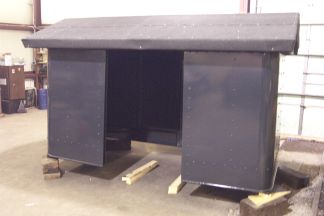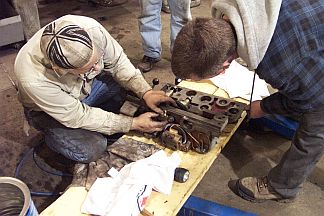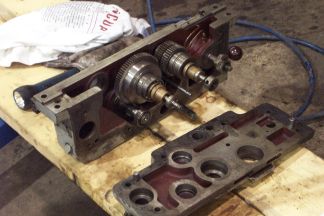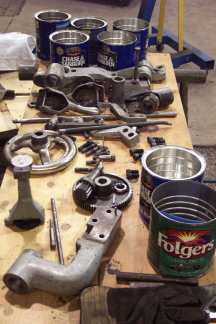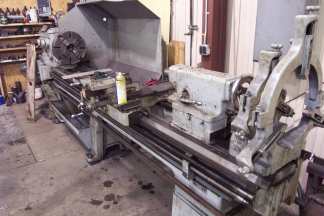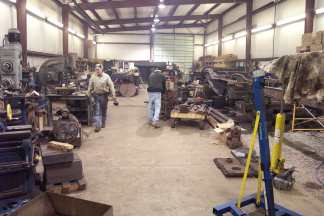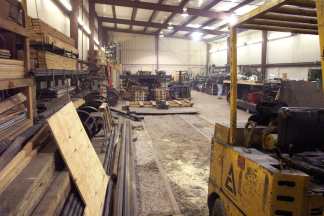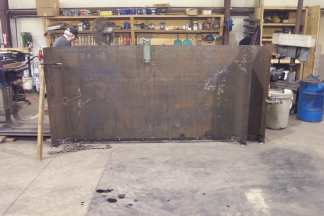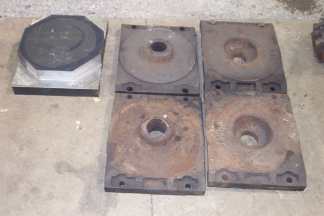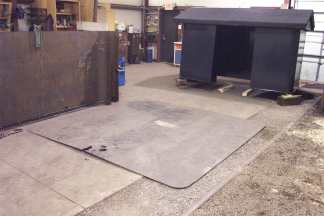|
Painted
coal bunker in the inverted position, with temporary protective
roof attached for long-term, outside storage.
|
Assembling
the cleaned and repaired carriage apron of the recently donated 20-inch
Lodge and Shipley engine lathe.
|
Apron
partly assembled after cleaning and lubricating all the individual
parts. This is as far as assembly could proceed due to the
fact
that replacement bearings could not be immediately acquired.
|
An
amazing amount of parts make up the workings of a relatively modern
industrial-sized lathe of the 1950's vintage. Luckily nothing
that would need to be purchased from Monarch Machine Tool at
outrageous prices was fount to be broken or worn out. All the
needed replacement bearings are still current items and
simply
needed to be ordered from firms specializing in the sale of such items
to end users.
|
This
is the Lodge and Shipley that we are currently in the process of
cleaning and repairing. Note that the apron that we are
working
on is missing from underneath the front of the carriage.
|
General shop view showing lots of locomotive pieces scattered
about.
In the foreground at the right is a pinion gear that has been separated
from its old shaft. Immediately above the gear is an array of
four
worn out swivel plates plus one of the new replacement plates being
machined from the solid plates shown stacked on a pallet at the foot of
the lathe on the left. In the background is the inverted coal
bunker
with its attached temporary roof. Viewers should have fun
identifying
other bits and pieces of the locomotive that are visible. |
|
Same shop, viewed from the opposite end. The fork-lift on the
right is
graciously loaned to the project every work session by the Park from
the Cass Shop. Without its use it would be very near
impossible to
handle the various locomotive components. |
Here
are two tank sides with the curved corners formed on their ends Along
the bottoms of each are steel angles with fabricated corner angles
welded to each end. Flat plates, not shown, will
connect
these two "U" shaped plates to form all four sides of the
tank.
The tank bottom, shown flat on the floor in this shot, will be welded
to the reinforcing angle that will be along all four sides of the
tank. Baffle plates, to control excessive water sloshing,
will
rivet to the sides of the tank at the three vertical rows of widely
spaced holes seen on the sheet in the foreground. Initial fitting up of
the tank components will be by bolting, but eventually every hole in
the tank will be filled by a round head rivet.
|
|
The four old bolster swivel
plates, which allow the trucks
to turn to adjust to the curvature of the track, are junk and will be
replaced
by ones newly machined from solid plates.
All four of the old plates are supposed to have a
raised circular
portion, like the old upper left plate.
This raised area allowed the heads of the opposing
mounting bolts to
bypass without interference. When
the
locomotive was taken apart it was noted that the heads of some of the
mounting
bolts were well worn away. Note
the differing
styles of depressions at the ends of the plates.
The octagonal portion of the new plate will
be turned circular as soon as the big lathe is back together, and freed
from
the job of removing the remains of old drive-shafts from the pinion
gears. Building up
with weld and salvaging the old
plates was not considered for a second, as welding on one face would
have
warped them tremendously.
|
Tank sides, bottom, and painted coal bunker. The bunker is
ready to go out the door for long-term outside storage.
|


